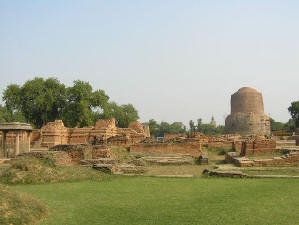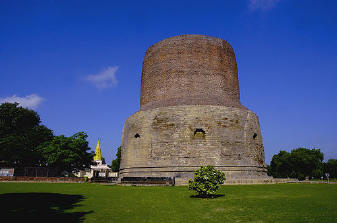Holy Destinations of India
Sarnath
Sarnath is a small village
in Uttar Pradesh, India, about 13 km north-east of Varanasi. It's famous as
the site of the deer park where Gautama Buddha first taught the Dharma and
also where the original Sangha was formed. Consequently, it is one of the 4
main Buddhist pilgrimage destinations.
Within the deer park complex is the large Dhamekha Stupa, constructed by the
Emperor Ashoka in 249 BCE, and several other Buddhist structures that were
added between the 3rd century BCE and the 11th century CE.
The town is relatively peaceful and green, and provides a welcome
accommodation alternative to those wishing to visit Varanasi but not be
immersed in it 24 hours a day
History of Sarnath
Sarnath derives its name from Saranganatha (Lord of the
Deer). After the Buddha attained enlightenment in Bodh Gaya, he came to
Sarnath. Here in the Deer Park, he delivered his first sermon or set in
motion the Wheel of Law (Maha Dharmachakra Pravartan.). On the day before
his death, the Buddha named Sarnath along with Lumbini, Bodh Gaya and
Kushinagar as the four places that his followers should consider sacred.
The Emperor Ashoka, who spread Lord Buddha's message of love and compassion
throughout his vast empire, visited Sarnath around 234 BC and constructed a
stupa here. Several Buddhist structures were built at Sarnath between the
3rd century BC and the 11th century AD and today this place has the most
expansive ruins among the places related to the Buddha.
Explorations during a recent Japanese-funded UNESCO project have yielded this "biggest Buddhist settlement in all of Central India." The remains point to monasteries of enormous proportions. Earlier, eight structures had been identified. Now, 14 more monasteries and 23 stupas have been found. The Archaeological Museum here as well as the Chinese and Tibetan Temples are all worth a visit.
Best Season, Climate, and Clothing
Due to its location near the Tropic of Cancer, Sarnath
enjoys a comfortable winter but a hot summer. During winter, the mercury can
dip to as low as 10°C at night and the daytime temperature remains around
20°C.
Summer brings a less comfortable weather situation. Begining in April and
continuing through June, it is extremely dry and daytime temperatures often
climb up to 45°C.
In late June or early July, the monsoon season brings torrential rains and
high humidity. Fortunately, the temperatures normally remain under 37°C,
although uncomfortably humid.
Area : 2.80 sq. km.
Altitude : 80.71 mtrs. Above sea level.
Season : October- March
Clothing (Summer) :Cootons
Winter) : Woollens
Language : Hindi, English
Festivals :Buddha Purnima (Full Moon, April –May), Anniversary of First Sermon (Full Moon, July-August)
Local Transport : Buses / Cycle –rickshaws / Auto –rickshaws / Taxis
STD Code : 0542
Photos of Sarnath
 |
 |
Tourist Attraction of Sarnath
CHAUKHANDI
STUPA
Chaukhandi is the first monument one encounters as one enters Sanath. It is
a lofty mound of brick –work whose square endifice is surrounded by a
octagonal tower. Originally said to built by Emperor Ashoka.
DHAMEK STUPA
The most remarkable structure at Sarnath, is the cylindrical Dhamek Stupa,
28 mts in diameter at the base and 43.6 mts in height, built partly of stone
and partly of brick. The stone facing the lower part is adorned with
delicate floral carvings of Gupta origin.
MULAGANDHA KUTI VIHAR
This mordern temple has been erected by the Mahabodhi Society. It has
excellent frescoes by Kosetsu Nosu japan’s foremost painter and is a rich
repository of Buddhist literature. The ancient Mulagandha Kuti temple is
among the brick ruins of Sarnath.
SARNATH MUSEUM
Sarnath yielded a rich collection of sculptures comprising numerous Buddha
and Bodhisattva images. Considerde amongst the finest specimens of Buddhist
art, these have been housed at the museum, adjiacent to the site. The museum
is open from 10 am to 5 pm, and closed on Fridays. Apart from the above the
other objects of lnterest at Sarnath are the Dharmrajika Stup, magnificent
Lion capital, India’s National Emblem at Sarnath museum, the Saddharmachakra
Vihar’s at excavated ruins.
How to Reach There :
AIR - The nearest airport is Babatpur : 30 km.
RAIL - Sarnath is directly connected by Varanasi- Gorakhpur Exp 0549 / 0550 and Varanasi – Bhatni- Varanasi Exp 0551/ 0552. See Varanasi also.
ROAD - Sarnath 10 km from Varanasi, is well connected by road
ACCOMMODATION
There are not many accommodation options available in Sarnath. It is better and more convenient to stay in Varanasi, where a number of accommodation options are available in all the three different segments.
- Forest Rest House, Sarnath.
- Mahabodhi Dharamshala, Sarnath.
- Jain Dharamshala, Sarnath.
- Tourist Bungalow, UPSTDC, Sarnath
Fairs and Festivals
On the day of Buddha Purnima, which is the new moon day in April/May, a big fair is held both in Sarnath and nearby Varanasi. It is to celebrate the day of the Buddha's birth, nirvana and death.